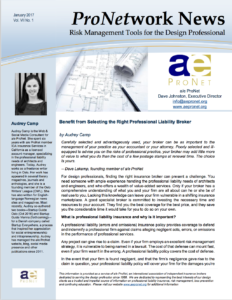 For design professionals, finding the right insurance broker can present a challenge. You need someone with ample experience handling the professional liability needs of architects and engineers, and who offers a wealth of value-added services. Only if your broker has a comprehensive understanding of what you and your firm are all about can he or she be of real use to you. Lacking this knowledge can leave your firm vulnerable in a shifting insurance marketplace. A good specialist broker is committed to investing the necessary time and resources to your account. They find you the best coverage for the best price, and they save you the considerable time it would take for you to do so on your own.
For design professionals, finding the right insurance broker can present a challenge. You need someone with ample experience handling the professional liability needs of architects and engineers, and who offers a wealth of value-added services. Only if your broker has a comprehensive understanding of what you and your firm are all about can he or she be of real use to you. Lacking this knowledge can leave your firm vulnerable in a shifting insurance marketplace. A good specialist broker is committed to investing the necessary time and resources to your account. They find you the best coverage for the best price, and they save you the considerable time it would take for you to do so on your own.
What is professional liability insurance and why is it important?
A professional liability (errors and omissions) insurance policy provides coverage to defend and indemnify a professional firm against claims alleging negligent acts, errors, or omissions in the performance of professional services.
Any project can give rise to a claim. Even if your firm employs an excellent risk management strategy, it is vulnerable to being named in a lawsuit. The cost of that defense can mount fast, even if your firm wasn’t in the wrong. A professional liability policy covers the cost of defense.
In the event that your firm is found negligent, and that the firm’s negligence gave rise to the claim in question, your professional liability policy will cover your firm for the damages you’re
legally obligated to pay, up to the policy limit. (Note: In most cases, defense costs erode the policy limit. Having adequate limits to cover both defense and indemnity is important.)
Why do I need a specialist insurance broker? Shouldn’t I be able to purchase my professional liability policy directly from an insurance company?
For architects and engineers, maintaining an active and adequate professional liability insurance policy is very often a legal requirement. And while a basic professional liability policy is straightforward enough for anyone to acquire, the insurance needs of design professionals are more complex than that.
The insurance industry is full of companies who want your business, but no two professional liability insurance carriers are exactly alike. Among the major differences are:
- the size of policy limits offered;
- whether multiyear policies are available;
- underwriting appetites for types of engineering services;
- and claims service.
Some companies require a 10-year loss history from design professionals, while others only require a five-year loss run. A specialist broker knows what the markets are doing, who the underwriters are, and how to present your firm in the best possible light. He or she will have understand each insurance company’s application and is quick to assist you in providing requested information. The cost of your insurance depends on this knowledge and attention to detail used on your behalf.
Here it should be noted that insurance companies often reward longevity. If your firm has been insured by a single company for a number of years and doesn’t have an especially adverse claims history, it’s likely that your premiums have been fair and endorsements (e.g., per project limit increases) have been easy to come by when needed. This does not mean that your current insurance company should be the only one to see your renewal application, however. A specialist broker understands the importance of approaching multiple markets periodically, either to reassure you that your policy is in the right hands or to grant you the opportunity to trade up.
Whether the market in a given year is hard or soft, a skilled professional liability insurance broker’s experience will benefit your firm. You need competent advice from a broker with the right perspective, both on your industry and the needs of your firm, as well as on the insurance marketplace as a whole.
This has been an excerpt of the January 2017 issue of ProNetwork News. Download the full free PDF version of Benefit from Selecting the Right Professional Liability Broker here.
About the Author
Audrey Camp is the Web & Social Media Consultant for a/e ProNet. She spent six years with a/e ProNet member IOA Insurance Services in California as a licensed account manager, specializing in the professional liability needs of architects and engineers. Today, Audrey works as a freelance writer living in Oslo, Norway. Her work has appeared in several literary magazines, journals and anthologies, and she is a founding member of the Oslo Writers’ League (OWL). She has also written for English-language Norwegian news sites and magazines. Most recently, Audrey co-authored two books—Startup Guide Oslo (Oct 2016) and Startup Guide Vienna (March 2017)—for a Danish company called Startup Everywhere, a process that inspired her appreciation for social entrepreneurship and intrapreneurship. Audrey has managed the a/e ProNet website, blog, social media presence and other publications since 2011.



 Copyright seems like a rather lofty notion. Few put copyright at the top of their list of must-haves in contract negotiations, and even fewer take the time to actually register their documents for copyright protection. But you do have copyright protections under current law. That copyright can come in handy as a risk management tool as well as leverage in a fee dispute. Unfortunately, many design professionals give away their rights vis-à-vis their contracts without a full appreciation of the implications of their actions.
Copyright seems like a rather lofty notion. Few put copyright at the top of their list of must-haves in contract negotiations, and even fewer take the time to actually register their documents for copyright protection. But you do have copyright protections under current law. That copyright can come in handy as a risk management tool as well as leverage in a fee dispute. Unfortunately, many design professionals give away their rights vis-à-vis their contracts without a full appreciation of the implications of their actions. At a panel for the NC Bar Association Construction Law Winter Meeting, attorney Melissa Brumback and her colleagues discussed insurance issues for design professionals. One hot topic was the way architects and engineers can inadvertently invalidate their insurance by agreeing to overly broad contractual language. Frequently, this has to do with the standard of care. Melissa penned the following post for the NC Construction Law Blog, and we have reposted it here with her permission:
At a panel for the NC Bar Association Construction Law Winter Meeting, attorney Melissa Brumback and her colleagues discussed insurance issues for design professionals. One hot topic was the way architects and engineers can inadvertently invalidate their insurance by agreeing to overly broad contractual language. Frequently, this has to do with the standard of care. Melissa penned the following post for the NC Construction Law Blog, and we have reposted it here with her permission:



